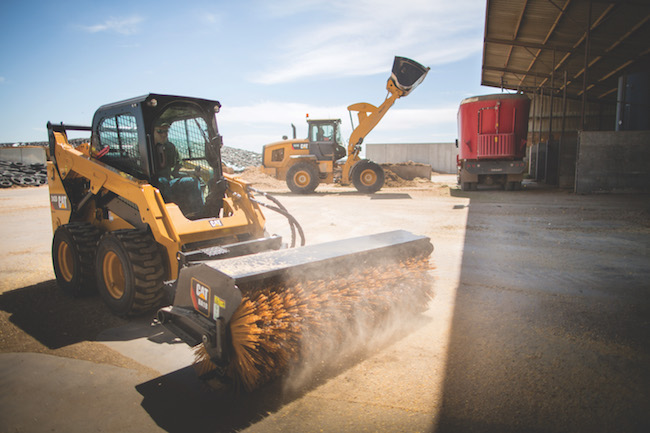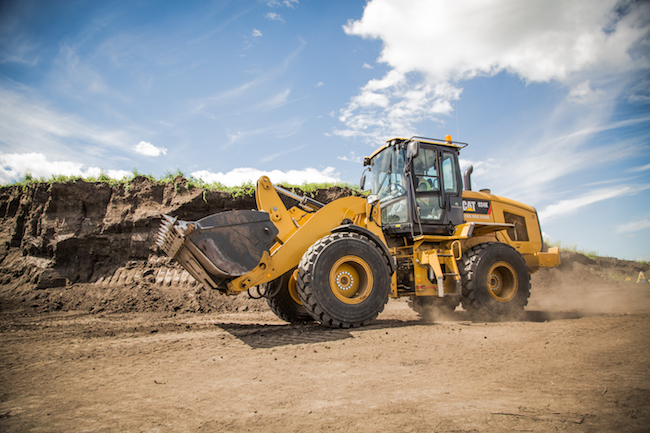

The ease with which you can attach or detach an attachment on small equipment adds to time-savings on a job. PHOTO: Finning
Smaller machines are making an impact. Visit any job site today and you’ll likely find more than one piece of compact equipment in the fleet.
An evolving construction industry has led to an increase in the use of small equipment on projects of all sizes. But what will the construction site of the future look like? As equipment continues to improve and become more technologically advanced, there is greater demand for ease of operation, fuel efficiency and versatility. Technologies such as grade control and telematics, once reserved only for larger machines, are now being utilized on compact equipment, contributing to an increase in productivity, safer job sites and more effective operators.
BIGGER ISN’T ALWAYS BETTER
Today’s operators are often expected to work in confined spaces and need greater maneuverability from their machines. Compact equipment allows operators easy access to confined areas where larger equipment can’t effectively maneuver. When you add in attachments and the equipment’s ability to perform many different tasks, a simple single-use device is turned into a multi-purpose machine.
From track-loaders and mini excavators, to backhoes and skid steers — compact equipment is improving productivity and efficiencies. Take the skid steer — a standard on most work sites, it’s now considered an essential piece of equipment. Their increased diversity and enhanced technology is translating into major productivity improvements, from earthmoving on a building site to landscaping a park.
The ease that you can attach or detach an attachment adds to the productivity and time-saving on a job. Whether it’s moving gravel, pushing snow or hauling hay bales, compact wheel loaders are another example of an attachment making jobs safer, faster and more precise while offering the improved fuel efficiency of a small machine.
IMPROVING ACCURACY AND MACHINE PERFORMANCE
Technology advancements have led to improved productivity and lower operating costs with better fuel efficiency, fewer emissions and more effective equipment that doesn’t need to operate at full capacity, all day, to be productive. Today, technology is available on equipment of any size, make or model. The right technology partner will work with you and provide the expertise needed to help increase efficiencies aligned with your business needs.

New technology continues to help less experienced operators become more productive quicker. PHOTO: Finning
Technology has also increased ease of operation. Equipment can be adjusted to operator skill levels, optimizing performance while staying safe on the job. For wheel loaders with hydrostatic transmissions, the machine’s response can also be adjusted with the push of a button to increase the tractive efforts on ice or mimic the neutral roll out of a traditional torque converter machine. New attachment technology like geo-fencing and locator devices mean owners and operators can track utilization and maintenance requirements to get a better understanding of usage and downtime.
MAKING JOB SITES SAFER
Technological advancements in equipment and attachments may lead to easier operation, but that doesn’t mean it can replace training. Educating operators is essential to ensuring everyone stays safe on the job site, while maintaining efficiency and productivity.
The enhanced features and adaptability of compact equipment have led to safer operations and made operators with fewer skills better, which is why training and site safety practices remain the most important element of efficient and safe operation of equipment on any job site.
Equipment advancements still don’t replace the need to follow standard operating procedures, however. This involves equipment inspections, walk-arounds before and after a job to check for leaks and other general maintenance issues, which if not addressed can lead to unsafe operation. Today’s machines can also be equipped with object detection technology — back-up cameras and 360 degree cameras, proximity sensors and alarms notifying the operator or other workers on-site when there may be an issue. These machines also have the ability to electronically limit dig depth and assist operator inputs in a balance between safety and productivity.
COMPANIES ARE SEEING THE BENEFITS
Next generation compact construction equipment is becoming more technologically advanced, even more compact, faster and fuel efficient. Innovations in machine technology on compact equipment is increasing productivity on job sites, providing a safer work environment and leading to better focus and performance from operators, who are able to spend more time concentrating on the task at hand.
Doug LeVoguer, Industry Business Manager, Building Construction Products for Finning Canada.
LeVoguer works as a liaison between dealers and manufacturers to provide insights into compact equipment products to help meet the customer’s needs.





